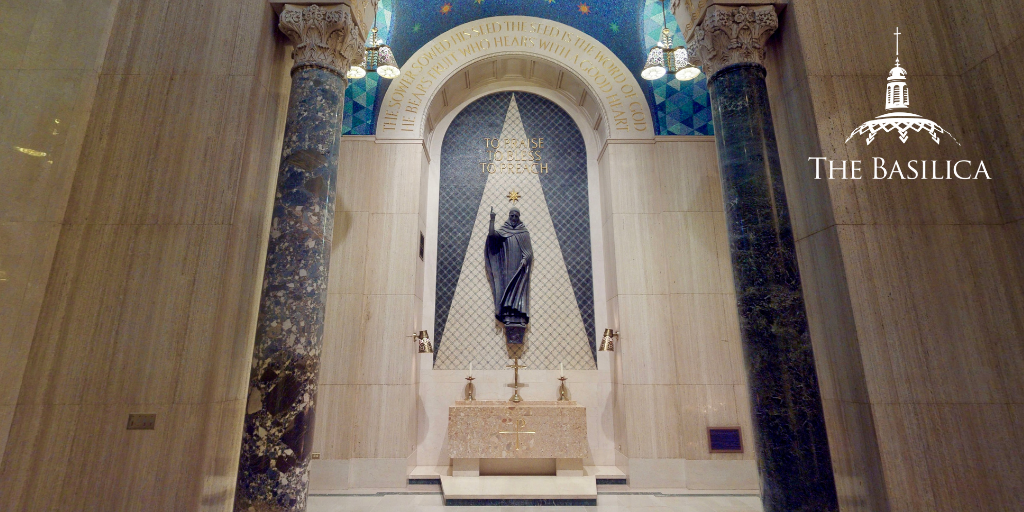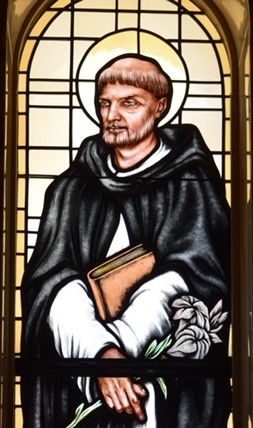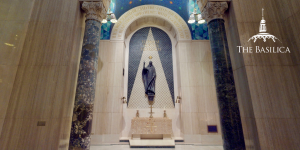
As we celebrate the Feast of Saint Dominic on August 8, we remember his vital work equipping spiritual teachers to give a reasoned defense of Christianity. Discover how he helped the Roman Catholic Church navigate a difficult conflict with a heretical faction and virtually explore where he is portrayed in the Basilica.
Early Life
Born to a noble family in Caleruega, Spain, in 1170, Saint Dominic attended a well-respected school at Palencia with the financial assistance of his uncle. Dominic set himself apart from his peers with his zeal for understanding the Scriptures and empathetic heart. He already displayed ascetic tendencies at an early age when he sold off his books to collect funds for the poor.

Saint Dominic and the Albigensians
Once he was ordained a priest, Saint Dominic embarked on a diplomatic mission to southern France with the goal of evangelizing unreached rural populations and combating the errant views of the Albigensian faction. The Albigensians believed in equal twin forces of good and evil in the world and associated all material substance with evil. As a result, they denied many critical doctrines, including the resurrection of the body and the incarnation of Christ.
Saint Dominic preached to people of this faction for years, but even after seven years of conflict between them and the Castilean government, there were few converts. However, one night, Dominic stayed at the house of an Alibigensian leader and discussed matters of theology until the rising of the sun. The conversation transformed the Albigensian man’s view of Christ – and consequently, St. Dominic’s view of missions by showing him the power of rational argumentation in mission work.
A Reasoned Defense of the Faith
Saint Dominic believed that rational argumentation – and not threats of violence or declarations of dogma – was the proper path to persuading dissenters. It was upon this conviction that he based the Order of Preachers in 1214. Today known as the Dominicans, this order was committed to the conversion of unbelievers and the re-conversion of non-practicing Catholics, focusing on scholarship, preaching, and spiritual education. Dominic believed that education was imperative to properly equipping preachers and winning people to the faith with reasoned, scholarly argument.
At the time of Saint Dominic’s passing at age 52 in 1221, the Dominican order had already expanded to 60 friaries across the continents, from Palestine to Scandinavia. Today, his legacy of compassion and dedication to the spiritual education of Church teachers serves as an enduring example of reasoned faith.
Virtually Tour the Saint Dominic Chapel
Located in the Great Upper Church, the Saint Dominic Chapel honors the 13th-century founder of the Order of Preachers (OP), commonly known as the Dominicans. A popular tradition holds that Saint Dominic was the original recipient of the devotion of the Rosary.
The burnished bronze statue in the center of the chapel was by created by Charles Umlauf and was one of the first bronze statues commissioned by the National Shrine. The chapel was dedicated by Patrick Cardinal O’Boyle of Washington and the Dominican provincials on May 17, 1970, and was a gift of the Dominicans.
Sources:
Butler’s Lives of the Saints (ed. by Bernard Bangley)
Cowan’s The Way of Saints
The Basilica Guidebook, Dr. Geraldine Rohling


